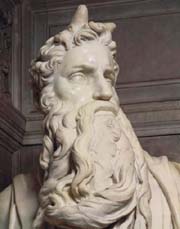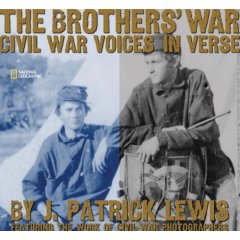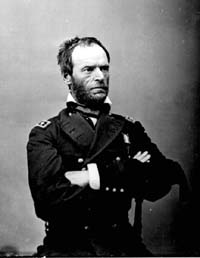Poetry Friday: Michelangelo, Moses, the March to the Sea, & tipping your hat to your neighbor
with J. Patrick Lewis
 February 8th, 2008 by jules
February 8th, 2008 by jules
Everything’s been comin’ up J. Patrick Lewis for me lately, as I’ve been reading two of his anthologies from last year, not to mention he sent 7-Imp a new one from an upcoming anthology, and I thought I’d share some of that Lewis goodness today. All three poems are printed in their entirety with permission from Lewis.
 First things first, then: Last year, Creative Editions released Michelangelo’s World, an anthology of poetry by Lewis which serves as “a small homage in sonnets” to one of history’s most celebrated artistic geniuses. Through fifteen sonnets, Lewis explores Michelangelo’s life (from his birth in the village of Caprese to his death at the age of 88); his temperament (“short-tempered, arrogant, and aloof”); and a handful of his most famous pieces of art, including the Doni Tondo, the David, the Sistine Chapel, and St. Peter’s. Each poem is accompanied with brief notes about that time period in the artist’s life and/or the piece of art which the poem celebrates. Images of his art work are also included along with a few original illustrations (including the cover art) from Swiss artist, sculptor, illustrator, and animator Etienne Delessert. I’m going to share Lewis’ poem about the sculpture of Moses, part of the tomb of Julius II in the church of San Pietro in Vincoli in Rome, which I’ve had the pleasure of seeing in person (and now that my father-in-law and his wife are about to head to Rome for a trip, I’m pining for it all once again).
First things first, then: Last year, Creative Editions released Michelangelo’s World, an anthology of poetry by Lewis which serves as “a small homage in sonnets” to one of history’s most celebrated artistic geniuses. Through fifteen sonnets, Lewis explores Michelangelo’s life (from his birth in the village of Caprese to his death at the age of 88); his temperament (“short-tempered, arrogant, and aloof”); and a handful of his most famous pieces of art, including the Doni Tondo, the David, the Sistine Chapel, and St. Peter’s. Each poem is accompanied with brief notes about that time period in the artist’s life and/or the piece of art which the poem celebrates. Images of his art work are also included along with a few original illustrations (including the cover art) from Swiss artist, sculptor, illustrator, and animator Etienne Delessert. I’m going to share Lewis’ poem about the sculpture of Moses, part of the tomb of Julius II in the church of San Pietro in Vincoli in Rome, which I’ve had the pleasure of seeing in person (and now that my father-in-law and his wife are about to head to Rome for a trip, I’m pining for it all once again).
Part of what interests me about this sculpture (other than its majestic beauty) is something Lewis references in his note about Moses next to the poem (so I’ll use his words): “The horns protruding from his head are a mistake of the Latin Vulgate Bible. ‘Rays of light’ in Hebrew was erroneously translated in the Vulgate as ‘horns.'”
There’s something about that mistake getting caught in stone for all eternity that is fascinating to me. Here’s the poem:

Marble, Rome, c. 1513–1516
The experts all agree on his great art,
The Pieta, the David, the Sistine,
And, twice as large as life to swell the scene,
Colossal Moses, fiery counterpart
Of Pope and sculptor both—a work of heart
One hundred inches high. Sitting between
Two lesser mortals, Moses might have been
For Michelangelo merely the start
Of his ambitious plan to celebrate
The life and death of Julius the Second with
A massive forty-figure tomb. But time
And politics conspired to alter fate.
The master leaped beyond the rim of myth:
The commonplace for him became sublime.
 Now, let’s jump ahead approximately 350 years to the year 1864 for the next poem. Last year, Lewis also released The Brothers’ War: Civil War Voices in Verse, published by National Geographic, which was met with much critical praise. Publishers Weekly described these poems as poignant and lyrical, adding “this heartrending collection of original poems paired with photographs by Civil War photographers makes real what statistics about war cannot — that the casualties of any war have human faces.” School Library Journal wrote, “skillfully using a variety of rhyming and rhythmic schemes to reinforce the message of each selection, Lewis honors fictionalized and historical heroes and does not shy away from the horrors of war,” adding that the period photographs in this anthology are “haunting.” The Horn Book review found the photographs and overall book design too overwhelming and in a wrestling match with the poems for the reader’s attention. But the review further praised Lewis’ “apt rhyming” and the “jagged rhythms” used for a “dark effect.”
Now, let’s jump ahead approximately 350 years to the year 1864 for the next poem. Last year, Lewis also released The Brothers’ War: Civil War Voices in Verse, published by National Geographic, which was met with much critical praise. Publishers Weekly described these poems as poignant and lyrical, adding “this heartrending collection of original poems paired with photographs by Civil War photographers makes real what statistics about war cannot — that the casualties of any war have human faces.” School Library Journal wrote, “skillfully using a variety of rhyming and rhythmic schemes to reinforce the message of each selection, Lewis honors fictionalized and historical heroes and does not shy away from the horrors of war,” adding that the period photographs in this anthology are “haunting.” The Horn Book review found the photographs and overall book design too overwhelming and in a wrestling match with the poems for the reader’s attention. But the review further praised Lewis’ “apt rhyming” and the “jagged rhythms” used for a “dark effect.”
I’m still reading the poems myself, but I agree that they are skillfully-crafted and show a more intense side of Lewis, known for his light verse. Here’s one of the poems, a fitting choice for today, the birth date of Major William T. Sherman:

(William Tecumseh Sherman
on his March to the Sea)
November 15 — December 21, 1864
From Atlanta to Savannah
In a winter month or more
Was a march called devastation
Like they’d never seen before.
They called it a destruction
Razed by sixty-thousand blues
To the city of Savannah —
Righteousness’s wreck crews.
Though my tactics were in question,
And I mapped a rugged route,
No one second-guessed the outcome
‘Cause it never was in doubt.
Oh, we robbed and burned and pillaged
As we gathered what we must
For the journey to the water
And we left behind disgust.
So Savannah was a Christmas gift
To Lincoln, thanks to me,
And a nail in the coffin of
Surrender, General Lee.
How ’bout those last two lines there? Excellent effect there with that line break . . . Though I’m not there yet, the book does include at its close a time line of selected events from the Civil War; a note about the book’s Civil War photographs from the Photography Editor of National Geographic Children’s Books, Lori Epstein; an Author’s Note on the eleven poems; and a bibliography.
Finally — speaking of Lewis’ light verse, as I did above — let’s change gears considerably, shall we? Yesterday, February 7th, was not only Chinese New Year, but it was also Wave All Your Fingers at Your Neighbor Day, and Lewis sent us a poem to commemorate it. This poem will be included in Countdown to Summer: A Poem for Every Day of the School Year, to be published by Little, Brown in Spring 2009 (“my forthcoming ‘big book’ — 180 poems,” Pat told us).
“Small Talk in the Neighborhood”
I said, “Hello, how do you do?”
He said, “Oh, pretty good, and you?”
He said, “Well, how about this rain?”
I said, “The weather’s been a pain.”
I said, “And when it rains, it pours.”
He said, “We’ll have to get the oars.”
There wasn’t any more to say—
We said the same thing yesterday.
Many thanks to Pat for sharing with us. Happy Poetry Friday to all. Gina at AmoXcalli will have the round-up today.

That Civil War book sounds amazing – what an awesome poem written in Sherman’s voice. I will be getting a copy of this one for myself; J. Patrick Lewis’s work never fails to impress me.
Jules,
I wrote a review of Lewis’s “Freedom Like Sunlight: Praisesongs for Black Americans” for Wild Rose Reader today. It’s a book that he spoke about–it hadn’t been published yet–at a children’s literature conference I attended several years ago in Maine.
He is an amazingly prolific poet, isn’t he? He’s also very personable and has a great sense of humor. “A Hippopotamusn’t” is still one of my favorite poetry books by Lewis.
Thnaks for posting the poems!
“A small homage in sonnets” Okay, you hooked me. I need to see that book!
Such a fascinating range of topics and styles.
Thanks, all.
Elaine, great minds think alike, what with our double whammy J. Patrick Lewis posts today. Can’t wait to read yours.
Thanks for the great sampling of Pat’s poetry. I saw that Moses sculpture too!
Love his humor. Must read more of his work.
Gah! Why have I not heard of these books before now? Must get my hands on Michelangelo and on the Civil War poems.
I do like that last one a lot. 🙂
(Oh, that horns thing is hilarious.)
WOW. The Civil War in poetry! I’m really liking this guy’s stuff, and you’re right, Elaine’s on him today too! How cool!
I do think the weather one should be printed on buses in Glasgow — we did all say the same thing yesterday, too….
Wave all your fingers at your neighbors day??? You’ve got to be kidding me. I ADORE that…
I’ve got to get this book. I’ve been a fan of Etienne Delessert even before he got into children’s books.
[…] wandering (welcome Laurel!),I imagine children’s faces are replacing flower potsin a fabulous March to the Sea.Oh to be of use!Beetle-bop, beetle-bop!The mouse of Amherst callsIt’s time for […]